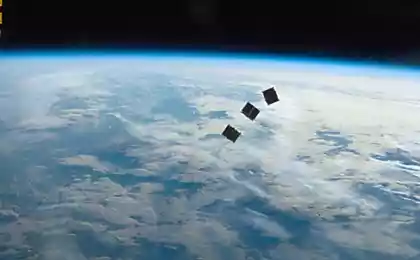1027
Happy Birthday, "Hubble"

Today is the birthday celebrating telescope "Hubble" - a joint project of NASA and the European Space Agency. The device is one of the largest observatories and NASA can operate in the infrared and ultraviolet ranges. Just how important is "Hubble" for science and what discoveries were made with the help of his pictures, Sci-One talked to Zelenyikot (Vitaly Yegorov), promoter of space exploration and employees of the private space company" Dauria Aerospace ». i>
- What is the value of "Hubble" in astronomy in general? B>
- Huge. Virtually no serious astronomical research is not without attracting the Hubble data. Its capabilities and accumulated over 25 years of data archive allow many studies of the universe, as well as to supplement or confirm certain hypotheses.
- What hypothesis confirmed "Hubble»? B>
- Observations of supernova explosions allowed to confirm the hypothesis of the Edwin Hubble telescope through which received the name of the recession of galaxies. The same observation was the basis of a new hypothesis about dark matter, which must be filled in intergalactic space.
- And what importance is the "Hubble" to popularize science? B>
- Pictures Hubble know, probably all. This is the most that neither is the popularization. "Hubble" opened the world the beauty of the universe.
- What's the biggest achievement "Hubble»? B>
- Difficult question. Definitely can not answer it. In my opinion, the main achievement of "Hubble" - is an opportunity to look into the universe for more than ten billion years ago. Ground facilities such is almost impossible to achieve.
- How do you think the future will be possible interstellar travel? B>
- They are still possible. Enough to disperse the spacecraft to a speed of 17 km / s. He will overcome the attraction of the sun and carry into interstellar space. Another thing is that such a flight to the nearest star takes tens of thousands of Earth years.
- Can I use the "Hubble" photographed, such as black holes? B>
- Black holes can not take a picture of anything, because light can not escape the event horizon. "Hubble" can lift a dense cloud of dust and gas around the black hole. Can observe the trajectory of stars around the black hole, and thus to estimate its weight and, most importantly - to confirm its presence.
- A extraterrestrial life? B>
- Extraterrestrial life can be photographed unless it fly up close enough. While "Hubble" is limited only by the discovery of planets around other stars, and their habitability - a problem other telescopes.
- Can you name the photos taken "Hubble" movement in time (after all objects in the photographs are in millions of light years from Earth)? B>
- It's more of a look into the past, and not moving. We'll just see what happened before. Similarly, as we hear thunder lightning, which has already disappeared.
- Is it possible to create a Russian analogue of "Hubble»? B>
- Maybe. Moreover, it has long been established, and in 2021 it planned to start. Russian observatory "Spektr-UV" should observe the universe in visible and ultraviolet range. Diameter mirror "Hubble" - 2, 4 meter diameter mirror "Spectrum-UV" - 1, 6 meters. Thus, the opportunities will be lower than the "Hubble," but given the fact that by the time "Hubble" has completed its work and the quality of its data will fall, our "Spectrum-UV" will take the place of the cult of the telescope.
Interviewed: Catherine Shutova , especially for Sci-One a >.
P.S. Friends are pleased to announce that we have opened a new popular science project Sci-One | First Scientific - this video blog about science. Subscribe, leave constructive criticism, we will take into account it.
Yes arrive with you science!
Source: geektimes.ru/company/vertdider/blog/249498/
Brain tumor woman was undeveloped twin
Road workers discovered fossilized dinosaur eggs laying in China






















